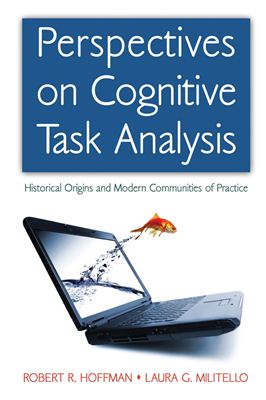Издательство Psychology Press, 2008, -540 pp.
The purpose of this book is to provide a context for understanding Cognitive Task Analysis (CTA) in terms of its historical roots and recent origins in the traditional disciplines and emerging communities of practice. In the chapters of this book, we show how CTA came to be what it is today. We show where the many CTA methods have come from and what they are intended to do. We also provide integration by showing the relations, dovetailings, common themes, and common purposes of the various disciplines that have contributed to our mode understanding of CTA. We especially focus on the convergence with regard to the design of information systems, including intelligent technologies.
This book is intended to be a companion to Working Minds: A Practitioner’s Guide to Cognitive Task Analysis (Crandall, Klein, & Hoffman, 2006), which goes into detail about the actual conduct of CTA methods. This book can also be seen as having a companion— Neville Moray’s History and Scope of Human Factors (2005), which reprints many of the classic writings that are cited and encapsulated in this Perspectives book, including works by John Annett, Frederick Gilbreth, Donald Norman, Jens Rasmussen, David Woods, the classic paper on man-machine task analysis by R. B. Miller, and others.
In addition to providing a summary at the end of each chapter, we included an advance organizer at the beginning of each chapter. These organizers take the form of Concept Maps that lay out the key ideas. As concept mapping spreads around the world in its various applications in research, education, and Web work (see Caсas et al., 2003; Caсas & Novak, 2006; Hoffman, Coffey, Novak, & Caсas, 2005; Hoffman & Linte, 2006; Novak, 1998), we present here a somewhat novel use of Concept Maps—to serve, in effect, as executive summaries. Lea more about CmapTools (including the research background) and get a free download at http://www.ihmc.us. A detailed how-to discussion of the use of Concept Maps as a knowledge elicitation method for creating knowledge models is in Crandall, Klein, and Hoffman (2006, chap. 4).
Part 1 History
Introduction to Section 1: History
A History of Task Analysis
The Evolution of Task Analysis into Cognitive Task Analysis: From Time and Motion Studies to Man–Machine Systems
Defining and Bounding Cognitive Task Analysis
Emergence of the Communities of Practice
Part 2 The Perspectives
Introduction to Section 2: The Perspectives
Cognitive Systems Engineering
Expertise Studies
Naturalistic Decision Making
Work Analysis
Sociological and Ethnographic Perspectives
Human-Centered Computing
Part 3 Synthesis
Introduction to Section 3: Synthesis
Synthesis: Divergences of the Perspectives
Synthesis: Convergences of the Perspectives
Synthesis: Convergence on the Topic of Teamwork and Team Cognition
Synthesis: Methodological Challenges for Cognitive Task Analysis
The purpose of this book is to provide a context for understanding Cognitive Task Analysis (CTA) in terms of its historical roots and recent origins in the traditional disciplines and emerging communities of practice. In the chapters of this book, we show how CTA came to be what it is today. We show where the many CTA methods have come from and what they are intended to do. We also provide integration by showing the relations, dovetailings, common themes, and common purposes of the various disciplines that have contributed to our mode understanding of CTA. We especially focus on the convergence with regard to the design of information systems, including intelligent technologies.
This book is intended to be a companion to Working Minds: A Practitioner’s Guide to Cognitive Task Analysis (Crandall, Klein, & Hoffman, 2006), which goes into detail about the actual conduct of CTA methods. This book can also be seen as having a companion— Neville Moray’s History and Scope of Human Factors (2005), which reprints many of the classic writings that are cited and encapsulated in this Perspectives book, including works by John Annett, Frederick Gilbreth, Donald Norman, Jens Rasmussen, David Woods, the classic paper on man-machine task analysis by R. B. Miller, and others.
In addition to providing a summary at the end of each chapter, we included an advance organizer at the beginning of each chapter. These organizers take the form of Concept Maps that lay out the key ideas. As concept mapping spreads around the world in its various applications in research, education, and Web work (see Caсas et al., 2003; Caсas & Novak, 2006; Hoffman, Coffey, Novak, & Caсas, 2005; Hoffman & Linte, 2006; Novak, 1998), we present here a somewhat novel use of Concept Maps—to serve, in effect, as executive summaries. Lea more about CmapTools (including the research background) and get a free download at http://www.ihmc.us. A detailed how-to discussion of the use of Concept Maps as a knowledge elicitation method for creating knowledge models is in Crandall, Klein, and Hoffman (2006, chap. 4).
Part 1 History
Introduction to Section 1: History
A History of Task Analysis
The Evolution of Task Analysis into Cognitive Task Analysis: From Time and Motion Studies to Man–Machine Systems
Defining and Bounding Cognitive Task Analysis
Emergence of the Communities of Practice
Part 2 The Perspectives
Introduction to Section 2: The Perspectives
Cognitive Systems Engineering
Expertise Studies
Naturalistic Decision Making
Work Analysis
Sociological and Ethnographic Perspectives
Human-Centered Computing
Part 3 Synthesis
Introduction to Section 3: Synthesis
Synthesis: Divergences of the Perspectives
Synthesis: Convergences of the Perspectives
Synthesis: Convergence on the Topic of Teamwork and Team Cognition
Synthesis: Methodological Challenges for Cognitive Task Analysis

